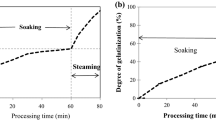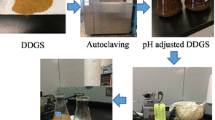Abstract
The thermo-physical properties of distillers’ spent grain (DSG) pellets are the key input parameters for the heat and mass transfer modeling of the drying process and for the design of the suitable drying and storage systems. The main thermo-physical properties like particle density, thermal conductivity, and specific heat capacity of DSG pellets were determined using standard laboratory methods. The effects of moisture content, percentage of condensed distillers’ solubles (also called solubles), and temperature on these selected properties were determined. The average particle density of the DSG pellets with 0, 10, 30, and 50 % solubles was found to be in the range of 898.8–1136.7 kg/m3. It was observed that the particle density of DSG pellets increased with an increase in condensed distillers’ soluble concentration and decreased with an increase in moisture content. Thermal conductivity (0.17–0.42 W/(mK)) and specific heat (1.76–3.47 kJ/(kgK)) of the DSG pellets increase linearly with an increase in moisture content, soluble concentration of the sample, and temperature of the drying medium. Three multiple linear regression equations were developed for predicting these properties as a function of moisture content, soluble concentration, and temperature with R 2 value ≥0.86.





Similar content being viewed by others
References
AACC Method 44-15A (2000). Moisture-air-oven methods. St. Paul: Approved Methods of the American Association of Cereal Chemists.
Ashtiani, S., Emadi, B., Sanaeimoghadam, A., & Aghkhani, M. (2014). Effect of moisture content and temperature on thermal behaviour of sesame seed. The Annals of the University Dunarea de Jos of Galati Fascicle VI—Food Technology, 38(1), 87–103.
Bourassa, J., Ramachandran, R. P., Paliwal, J., & Cenkowski, S. (2015). Drying characteristics and moisture diffusivity of distillers’ spent grains dried in superheated steam. Drying Technology, 33, 2012–2018.
Choi, Y., & Okos, M. R. (2004). Thermal conductivity of foods. In D. R. Heldman (Ed.), Encyclopedia of agricultural, food, and biological engineering (pp. 1004–1010). New York: Marcel Dekker Inc.
Defraeye, T. (2014). Advanced computational modelling for drying processes—a review. Applied Energy, 131, 323–344.
Drouzas, A. E., Maroulis, Z. B., Karathanos, V. T., & Saravacos, G. D. (1991). Direct and indirect determination of the effective thermal diffusivity of granular starch. Journal of Food Engineering., 13(2), 91–101.
Dutta, K. S., Nema, V. K., & Bhardwaj, R. K. (1988). Thermal properties of gram. Journal of Agricultural Engineering Research, 39(4), 269–275.
Elansari, A. M., & Hobani, A. I. (2009). Effect of temperature and moisture content on thermal conductivity of four types of meat. International Journal of Food Properties, 12, 308–315.
Emami, S., Tabil, L. G., & Tyler, R. T. (2007). Thermal properties of chickpea flour, isolated chickpea starch, and isolated chickpea protein. Transactions of the ASABE, 50(2), 597–604.
Erriguible, A., Bernada, P., Couture, F., & Roques, N. (2006). Simulation of superheated steam drying from coupling models. Drying Technology, 24, 941–951.
Fitch, A. L. (1935). A new thermal conductivity apparatus. American Journal of Physics, 3(3), 135–136.
Hamawand, I. (2011). Effect of colloidal particles associated with the liquid bridge in sticking during drying in superheated steam. International Journal of Engineering, 24(2), 119–126.
Hamawand, I. (2013). Drying steps under superheated steam: a review and modelling. Journal of Energy and Environment Research, 3(2), 107–125.
Hamawand, I., Yusaf, T., & Bennett, J. (2014). Study and modelling drying of banana slices under superheated steam. Asia-Pacific Journal of Chemical Engineering, 9, 591–603.
Husky Energy (2016). http://www.huskyenergy.com/huskyproducts/canada.asp. Accessed on May and 1 Aug 2016.
Iyota, H., Nishimura, N., Yoshida, M., & Nomura (2007). Simulation of superheated steam drying considering initial steam condensation. Drying Technology, 19(7), 1425–1440.
Jancazak, D. (2013). The effect of temperature, composition and phase of the composting process on the thermal conductivity of the substrate. Ecological Engineering Journal, 61, 354–357.
Jian, F., Jayas, D. S., & White, N. D. G. (2013). Specific heat, thermal diffusivity, and bulk density of genetically modified canola with high oil content at different moisture contents, temperatures, and storage times. Transactions of the ASABE, 56(3), 1077–1083.
Johnson, P., Cenkowski, S., & Paliwal, J. (2011). Bulk density and angle of repose of distiller ’ s spent grain under different drying methods and soluble concentrations. Winnipeg, Manitoba: CSBE/SCGAB 2011 Annual Conference Inn at the Forks 10-13 July 2011. Paper No. CSBE11-318.
Johnson, P., Paliwal, J., & Cenkowski, S. (2013). Superheated steam drying characteristics of single cylindrical compacts produced from wet distiller’s spent grain. In Proceedings of CSBE/SCGAB 2013 Annual Conference, Saskatchewan 7–10 July 2013. Paper No. CSBE13–11.
Johnson, P., Paliwal, J., & Cenkowski, S. (2014). Analysis of the disintegration of distiller’s spent grain compacts as affected by drying in superheated steam. Drying Technology, 32, 1060–1070.
Johnson, P., Paliwal, J., & Cenkowski, S. (2015). Effect of solubles on disintegration of distiller’s spent grain compacts during superheated steam drying. Drying Technology, 33(6), 671–683.
Kaliyan, N., & Morey, R. V. (2009). Factors affecting strength and durability of densified biomass products. Biomass and Bioenergy, 33(3), 337–359.
Kustermann, M., Scherer, R., & Kutzbach, H. D. (1981). Thermal conductivity and diffusivity of shelled corn and grain. Journal of Food Process Engineering, 4, 137–153.
Mahapatra, A. K., Lan, Y., & Harris, D. L. (2011). Influence of moisture content and temperature on thermal conductivity and thermal diffusivity of rice flours. International Journal of Food Properties, 14, 675–683.
Mani, S., Tabil, L. G., & Sokhansanj, S. (2003). An overview of compaction of biomass grinds. Powder Handling and Processing, 15(2), 160–168.
Mannheim, H. C., Steinberg, M. P., Nelson, A. I., & Kendall, T. W. (1957). The heat content of bread. Food Technology, 11(7), 394–388.
Modi, S. K., Durga, P. B., & Basavaraj, M. (2014). Effect of moisture content and temperature on thermal conductivity of Psidium guajava L. by line heat source method (transient analysis). International Journal of Heat and Mass Transfer, 78, 354–359.
Mohseni, N., & Zaske, J. (1976). Stress relaxation and energy requirements in compaction of unconsolidated materials. Journal of Agricultural Engineering Research, 21, 193–205.
Mohsenin, N. N. (1980). Thermal properties of foods and agricultural materials. New York: Gordon and Breach Science Publishers.
Mosqueda, M. R., Tabil, L. G., & Muthukumarappan, K. (2013). Effects of condensed distillers solubles and drying temperature on the physico-chemical characteristics of laboratory-prepared wheat distillers grain with solubles. International Journal of Agricultural and Biological Engineering, 6(2), 73–85.
Mosqueda, M. R., Tabil, L. G., & Muthukumarappan, K. (2014). Physico-chemical characteristics of wheat distillers dried grain with solubles sourced from a Saskatchewan ethanol plant. Canadian Biosystems Engineering, 56, 3.1–3.15.
Muir, W. E., & Viravanichai, S. (1972). Specific heat of wheat. Journal of Agricultural Engineering Research, 17(4), 338–342.
Nesvadba, P. (1982). Methods for the measurement of thermal conductivity and diffusivity of foodstuffs. Journal of Food Engineering, 1(2), 93–113.
Pakowski, Z., & Adamski, R. (2011). On prediction of the drying rate in superheated steam drying process. Drying Technology, 29, 1492–1498.
Payne, J. D. (1978). Improving quality of pellet feeds. Milling Feed and Fertilizer, 162(5), 34–41.
Pickard, G. E., Roll, W. M., & Ramser, J. H. (1961). Fundamentals of hay wafering. Transactions of ASABE, 4(1), 65–68.
Rahman, S. (1991). Evaluation of precision of the modified Fitch method for thermal conductivity measurement of foods. Journal of Food Engineering, 14, 71–82.
Samuelsson, R., Larsson, S., Thyrel, M., & Lestander, T. A. (2012). Moisture content and storage time influence the binding mechanisms in biofuel wood pellets. Applied Energy, 99, 109–115.
Serrano, C., Monedero, E., Lapuerta, M., & Portero, H. (2011). Effect of moisture content, particle size and pine addition on quality parameters of barley straw pellets. Fuel Processing Technology, 92, 699–706.
Sousa, S. C. L., Silva, J. P., Ramos, A. M. M., & Simões, R. M. S. (2007). Pulping and papermaking potential of brewery’s spent grain. Cellulose Chemistry and Technology, 41(2), 183–191.
Sreenarayanan, V. V., & Chattopadhyay, P. K. (1986). Thermal conductivity and diffusivity of rice bran. Journal of Agricultural Engineering Research., 34, 115–121.
Stitt, F., & Kennedy, E. K. (1945). Specific heats of dehydrated vegetables and egg powder. Food Research International, 10(5), 426–436.
Stroem, L. K., Desai, D. K., & Hoadley, A. F. A. (2009). Superheated steam drying of brewer’s spent grain in a rotary drum. Advanced Powder Technology, 20, 240–244.
Suvarnakuta, P., Devahastin, S., & Mujumdar, A. S. (2007). A mathematical model for low pressure superheated steam drying of biomaterial. Chemical Engineering and Processing, 46(7), 675–683.
Thomas, M., Van-Vliet, T., & Van-der-Poel, A. F. B. (1998). Physical quality of pelleted animal feed. 3. Contribution of feedstuff components. Animal Feed Science and Technology, 70(1–2), 59–78.
Tumuluru, J. S., Tabil, L., Opoku, A., Mosqueda, M. R., & Fadeyi, O. (2010). Effect of process variables on the quality characteristics of pelleted wheat distiller’s dried grains with solubles. Biosystems Engineering, 105(4), 466–475.
Waszkielis, K. M., Wronowski, R., Chlebus, W., Bialobrzewski, I., Dach, J., Pilarski, K., & Jancazak, D. (2013). The effect of temperature, composition and phase of the composting process on the thermal conductivity of the substrate. Ecological Engineering Journal, 61, 354–357.
Waszkielis, K. M., Białobrzewski, I., Nowak, K. W., Dzadz, & Dach, J. (2014). Determination of the thermal conductivity of composted material. Measurement: Journal of the International Measurement Confederation, 58, 441–447.
Xiros, C., Topakas, E., Katapodis, P., & Christakopoulos, P. (2008). Hydrolysis and fermentation of brewer’s spent grain by Neurospora crassa. Bioresource Technology, 99(13), 5427–5435.
Yang, W., Sokhansanj, S., Tang, J., & Winter, P. (2002). Determination of thermal conductivity, specific heat and thermal diffusivity of borage seeds. Biosystems Engineering, 82(2), 169–176.
Zielinska, M. (2016). Thermophysical properties of laboratory-prepared corn/wheat dried distiller’s grains and dried distillers solubles dehydrated with superheated steam and hot air. Drying Technology, 34(10), 1147–1161.
Zielinska, M., & Cenkowski, S. (2012). Superheated steam drying characteristic and moisture diffusivity of distillers’ wet grains and condensed distillers’ solubles. Journal of Food Engineering, 109(3), 627–634.
Zielinska, M., Cenkowski, S., & Markowski, M. (2009). Superheated steam drying of distillers’ spent grains on a single inert particle. Drying Technology, 27(12), 1279–1285.
Zuritz, C. A., Sastry, S. K., McCoy, S. C., Murakami, E. G., & Blaisdeh, J. L. (1989). A modified Fitch device for measuring the thermal conductivity of small food particles. Transactions of ASAE, 32(2), 711–718.
Acknowledgments
The authors acknowledge the Natural Sciences and Engineering Research Council of Canada and University of Manitoba Graduate Fellowship for their financial support. Thanks are also due to NSERC-funded summer research assistants, Jennifer Pieniuta, Clifford Dueck, and Craig Heppner, for their technical assistance.
Author information
Authors and Affiliations
Corresponding author
Rights and permissions
About this article
Cite this article
Ramachandran, R.P., Paliwal, J. & Cenkowski, S. Thermo-Physical Properties of Distillers’ Spent Grain Pellets at Different Moisture Contents and Condensed Distillers’ Soluble Concentrations. Food Bioprocess Technol 10, 175–185 (2017). https://doi.org/10.1007/s11947-016-1807-x
Received:
Accepted:
Published:
Issue Date:
DOI: https://doi.org/10.1007/s11947-016-1807-x




